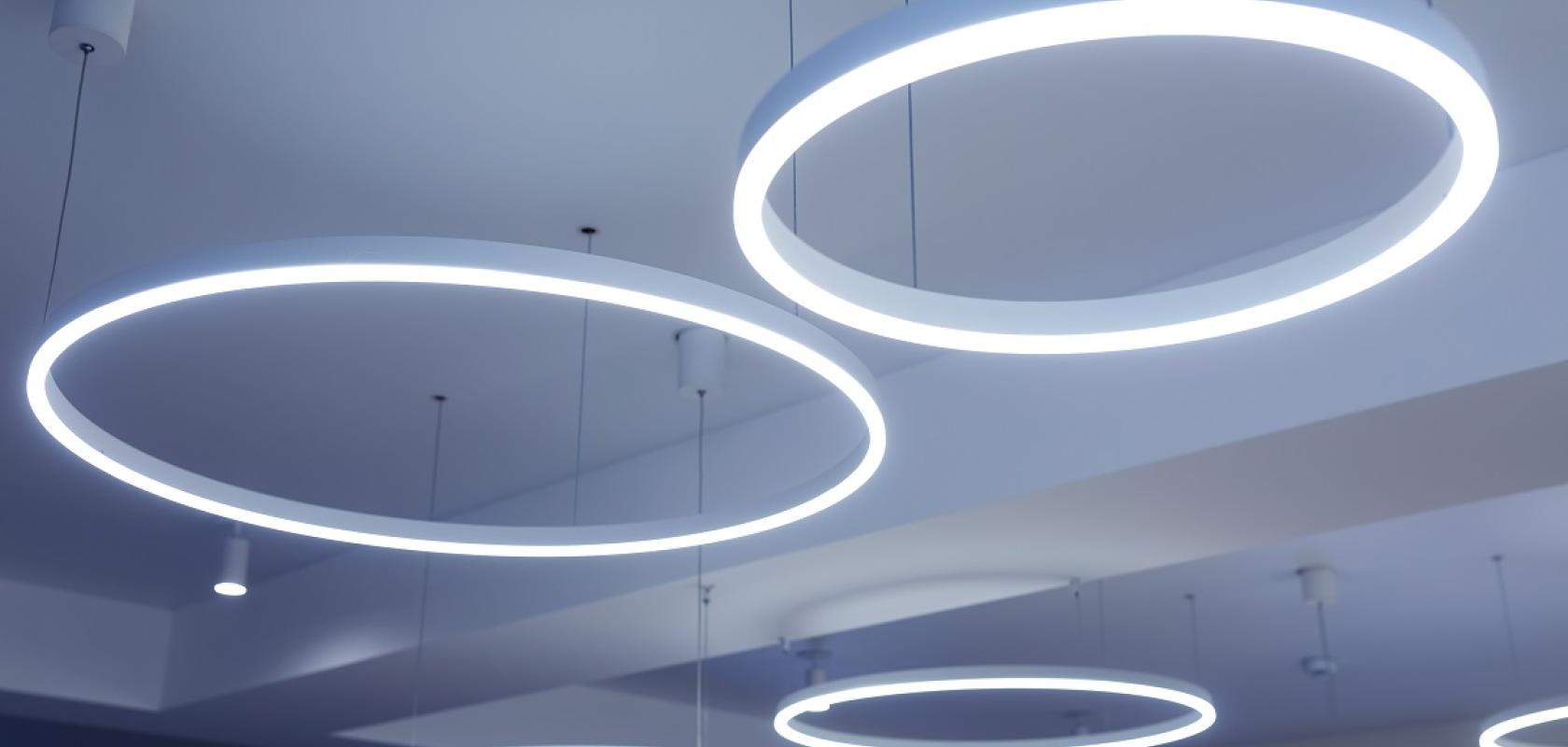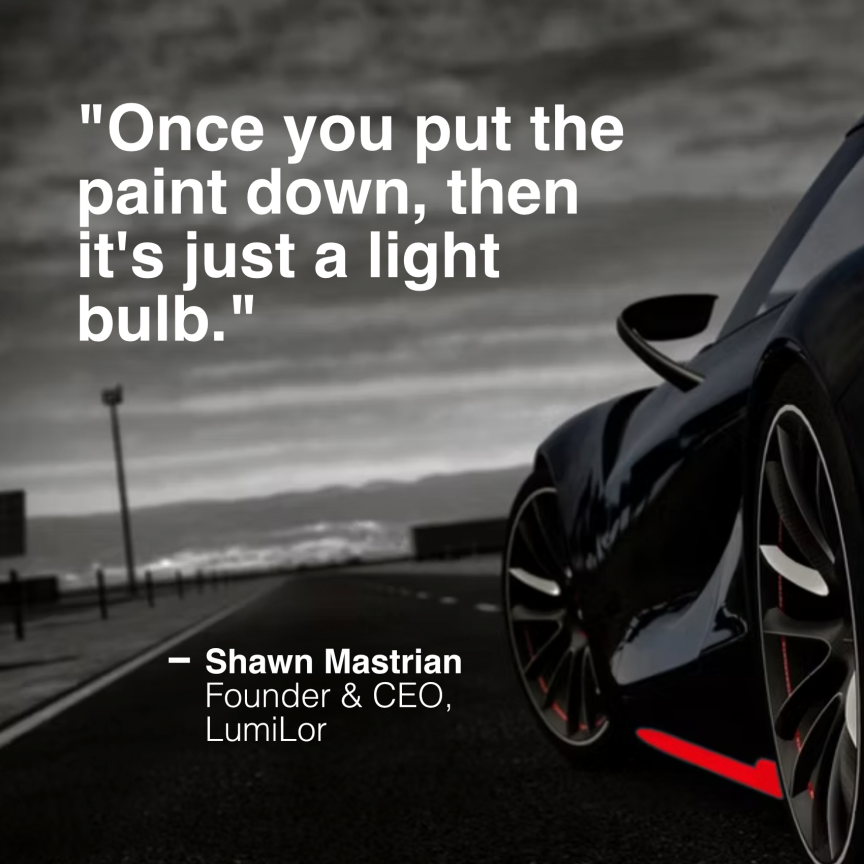Thanks to decades of global investment, and rapid research and development, energy conversion efficiencies in today’s finest LEDs are reaching 65 per cent, while figures in incandescent lamps barely nudge 20 per cent.
But ask LED industry veteran, Mike Krames, if he thinks further increases in efficiency are still important in white light LEDs, and his answer is a resounding yes.
As the president of LED consulting firm, Arkesso, and past executive at LED lighting giants Philips Lumileds and Soraa, puts it: ‘Our top tier LED leaders will continue to fight for every little percentage point of efficiency – not only because there is the benefit of less power consumption for the end user, there’s also the important benefit of less heat generation.’
Right now, lighting accounts for nearly five per cent of global carbon dioxide emissions, a number not lost on many that attended this year’s United Nations Climate Change Conference, COP26. Indeed, as countries worldwide are scrambling to cap emissions and limit global warming to 1.5ºC, an LED efficiency point here and there can only help.
According to Krames, the inextricable, and non-linear, link of more light generation for less heat generation is still often overlooked. ‘Raise your LED efficiency from, say, 70 to 80 per cent and you drop your heat load by a third, which actually means you can increase [LED] power by more than that amount,’ he said. ‘So an end user can then perhaps buy fewer LEDs or make energy savings with the same number of more efficient LEDs, or the manufacturer could drop the heat load and use a lower cost thermal solution.
‘Increases in efficiency pay back in incredible ways, and the LED manufacturer, luminaire manufacturer and end user all get to share in that value,’ he adds.
And this is what industry players far and wide have been focusing on. In recent years, LED lighting has reached – and passed – the point where it is the best option for almost all lighting applications. Luminous efficacy is a measure of how well a light source produces visible light, and over the last two decades, the efficacy of white LED packages has risen from around 25 lumens per watt to more than 160 lumens per watt, depending on colour quality and LED driver conditions. In contrast, the luminous efficacy of a typical incandescent bulb for 120V operation is 16 lumens per watt, and some 60 lumens per watt for a compact fluorescent bulb.
Factor in the ongoing cost decreases in LED packaging, and today’s LED luminaire can be cost-competitive with other lighting products and offer a lower cost of ownership across its life cycle. Indeed, the 2021 European Commission Joint Research Centre report on LED lighting indicates LED sales now exceed fluorescent lamps as LED costs continue to fall. Figures show LED market share rose from five per cent in 2013 to nearly half of all global lighting sales in 2019, with integrated LED luminaires making up an increasing share.
Meanwhile, Germany-based analyst business, Statista, recently forecast the penetration of LEDs into the global lighting market to reach around 76 per cent come 2025. And what we have seen of LEDs so far is a mere glimpse of what could come next.
The wonder of phosphors
Despite the advantages of LEDs, incandescent light sources beat these devices hands down when it comes to light quality – while the incandescent bulb emits a warm, sunlight-like glow, the LED emits a colder, bluish light. Indeed, the colour rendering index (CRI), which measures the ability of a light source to accurately reproduce the colours of the object it illuminates, is 100 for an incandescent bulb, matching that of sunlight. In contrast, the CRI for a relatively cheap LED is 75, due to its weak output in the red spectral region.
Your everyday LED typically comprises a blue indium gallium nitride (InGaN) LED housed in a dome-shaped cap that’s been coated with a yellow yttrium aluminium garnet (YAG) phosphor powder, doped with the rare earth, cerium. The phosphor absorbs the blue light and converts it to yellow light, which combines with the blue light to generate the cool-white light.
To more closely mimic sunlight, LED makers worldwide have been trying to develop alternative phosphors that deliver a CRI closer to 80. As early as 2014, researchers from the University of Munich discovered a red-emitting europium-doped strontium nitridoaluminate phosphor – Sr[LiAl3N4]:Eu2+ – that could be efficiently excited by blue LEDs. Lumileds has since used the phosphor to raise the CRI in its commercial white light LEDs.
Also, University of Innsbruck researchers have worked with Osram on a Sr[Li2Al2O2N2]:Eu2+ phosphor that emits red light, without infrared light, raising its luminous efficacy. And in another example, US conglomerate, GE, has developed a family of phosphors based on potassium fluorosilicate doped with manganese, which deliver a robust narrow red-band performance.
Clearly progress is underway, but as Professor Jakoah Brgoch, a materials chemist at the University of Houston investigating materials systems for solid-state white lighting, points out: ‘There are only a few red phosphors that are available and useful, and this is one of the key things that continues to drive the price of these warmer white LEDs up.’
Brgoch also points to the thorny issue of phosphor stability, which as he said, is a huge area of research. ‘As the LED chip gets hotter, the phosphor’s optical properties can degrade, so instead of having stable white light, the white light shifts – and no-one wants to turn on a light bulb that keeps changing colour throughout the day,’ he said.
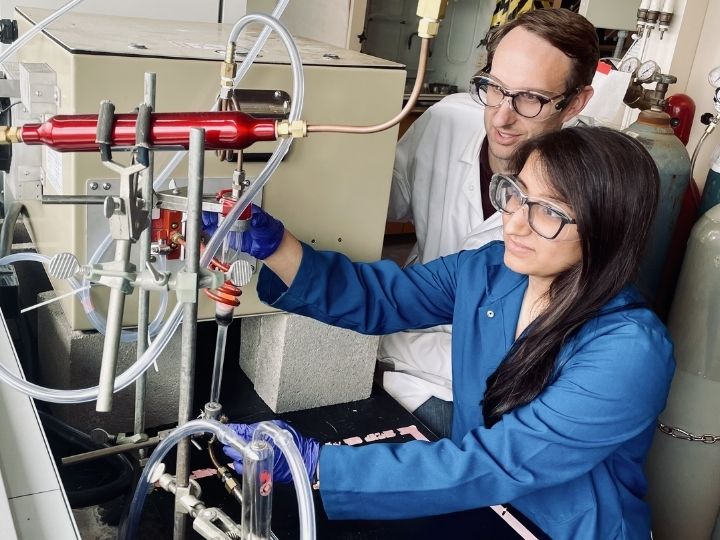
Professor Jakoah Brgoch and Shruti Hariyani adjust a phosphor sample during development of their violet LED chip. (Image: Hariyani)
To speed up the search for new phosphors, Brgoch developed a machine learning platform back in 2018, to swiftly identify efficient and thermally robust rare-earth substituted inorganic phosphors for white LEDs, which may have been overlooked during traditional chemical synthesis. He has already used the platform to screen thousands of possible inorganic phosphors and identified a sodium barium borate (NaBaB9O15) phosphor, that when doped with europium, emitted violet light. ‘We went on to make this material – it had an excellent thermal stability and a quantum yield of 95 per cent – that was a pretty exciting discovery,’ said Brgoch.
This time around, the light was too blue to be commercially desirable in white LED lighting, but Brgoch is now creating green-emitting phosphors based on the europium-doped sodium barium borate. He is certain the material has huge potential for LED-based lighting and also display systems.
‘Think about it – every LED bulb in the world is based on only a handful of materials, which means intellectual property and patent licencing costs are huge as everyone is using the same materials in a very constrained market,’ he said. ‘And this is why we are trying to make new materials that can help to break the marketplace open.’
In a further twist to the LED tale, research has also drawn a link between continued exposure to its blue-tinted light and health issues such as fatigue, mood disorders, cataract formation and insomnia.
Scientists now suspect that over-exposure to the blue light from your typical cool-white LED suppresses melatonin and disrupts the circadian rhythms that govern our sleep-wake cycles.
Given this, Brgoch and his graduate assistant student, Shruti Hariyani, have developed a prototype of a different kind of white LED that uses a violet LED instead of your usual blue device.
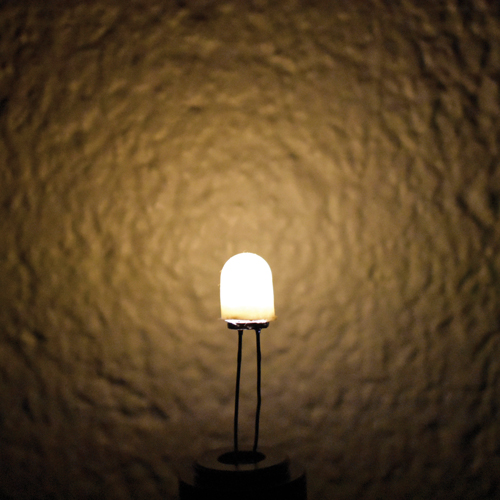
The prototype while light, based on a violet LED, developed by Professor Jakoah Brgoch and Shruti Hariyani. (Image: Hariyani)
‘Melatonin suppression [is associated] with blue light so we started to investigate if we could use violet light to skip the melatonin suppression curve and still make white light,’ said Brgoch. ‘You still need some blue light but the idea is to minimise its intensity.’
Finding a blue phosphor that can pair with a violet LED was no mean feat, but the researchers discovered a new blue-emitting phosphor doped with europium, Na2MgPO4F:Eu2+-. By using this alongside red-emitting and green-emitting phosphors, they fabricated a device that minimises blue emission to deliver more sunlight-like light.
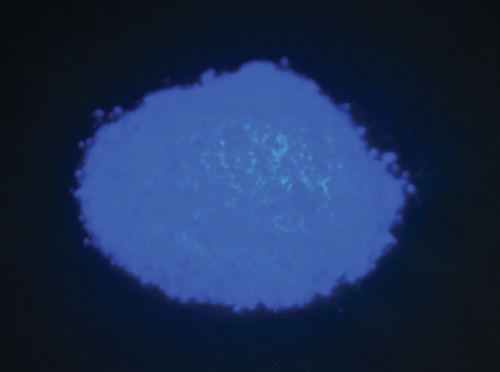
The blue-emitting phosphor – Na2MgPO4F:Eu2+ – created by Professor Jakoah Brgoch and Shruti Hariyani for their violet LED. (Image: Hariyani)
‘The prototype device... produces a warm white light with a higher colour rendering index than a commercially purchased LED light bulb,’ Brgoch highlighted. ‘We’re now in the process of scaling [phosphor] synthesis so we can make it in larger amounts and get it into the hands of companies.’
Brgoch and cohorts are hardly alone in their venture to deliver a ‘kinder’ LED. For example, earlier this year, GE released its ‘sun filled’ LED bulb described as its closest light to natural sunlight, which could help maintain the body’s natural sleep-wake cycle. Such bulbs are still pricey but are a sign of what could follow.
Beyond the blue
Krames is certain that industries far and wide can benefit from different wavelength LEDs beyond blue. For example, he highlights how violet light can excite the optical brightening agents that enhance the brightness of white objects. ‘My favourite example is a bridal gown shop,’ he said. ‘If you have the sun during the day, the [dresses] look great but take the sun away and show these under standard blue-only LEDs and they can look yellow – violet light can be important here.’
Similarly, he points out how infrared light can benefit general cell health – the effects from IR photostimulation and photobiomodulation are now known to aid wound healing and even cancer treatment. According to the Arkesso President, gallium arsenide-based infrared LEDs have been developed for decades but haven’t had the same market push as the nitride materials used in white lighting applications. Also factor in some tough materials strain issues that take place during structure fabrication, and these devices only have a power conversion efficiency of about 30 per cent – at the moment.
‘We get a tonne of infrared light from the sun... so shouldn’t we also be considering this wavelength for indoor illumination also?’ he asked. ‘If other applications really take off, maybe there will be a wake up call where people realise we could use light wavelengths [other than the blue LED] for health applications.’
Krames is also excited about the future of the ultraviolet C LED, which is steadily making in-roads to germicidal irradiation applications for surface, air, water and food disinfection. Efficiency and cost has trailed the blue LED, in part due to the fact that gallium nitride is not transparent to UV-C radiation, but rapid progress is underway.
As Krames highlighted, just last year both Riken, Japan, and Bolb, US, revealed transparent structures and devices that circumvent this issue. Bolb has joined the growing list of companies shipping UV-C LED products, including Nichia, Seoul Viosys, South Korea, and Crystal IS, US. ‘I hope eventually [this technology] eradicates UV mercury lamps, much like the white light LED has been doing [for incandescents],’ said Krames.
But the future of LEDs lies some way beyond the humble LED bulb. Today, myriad LED lighting systems from the likes of Philips and Trilux comprise a range of LED luminaires with analog and digital controls to deliver different types of lighting to different places, at different times of the day. As part of this, human-centric lighting is on the rise, in which the intensity and colour quality of LED light in any such set-up is adjusted across a day to mimic natural daylight patterns.
Such developments fall in line with the vision of a ‘smart building’, which calls for integrated systems control to ensure lighting, heating, ventilation and air conditioning, and other systems, work together to optimise energy use and building performance. And as part of this, a multitude of activities, including electricity generation and transmission, as well as the sending and receiving of data on energy use, will all be monitored.
Given this, Clifton Lemon, CEO of lighting and energy consultancy, Clifton Lemon Associates, and business development director of the California Energy Alliance, believes it’s time to look beyond energy efficiency and focus firmly on building systems control. ‘LED lighting has a big role to play in smart buildings and the industry needs to be thinking about much better [lighting systems] design and control,’ he said.
‘LEDs started out with the idea of energy efficiency... and are now super efficient – so now we need to be dealing with resiliency, load management and control of our building systems,’ he added. ‘This is going to be a huge challenge that doesn’t seem to be on people’s radar yet – but lighting is right in the middle of it.’
By way of example, Lemon points to how today’s lighting occupancy-sensor systems, which detect when a space is unoccupied and dim the lights to save energy, could also be applied to other building services, including HVAC. However, for him, the biggest challenge isn’t technology but changing people’s mindsets.
‘Building systems players tend to think about equipment they have and how it fits within a building – as a rule, they don’t think about how it works with systems in other buildings – and this kind of thinking is a very big change for the industry,’ he said. ‘We’re going to see patchwork solutions for the foreseeable future... but progress is being made and market conditions are forcing us to deal with the change.’
Still, as industry acclimatises to a bright and intelligent future, Krames is firm that efficiency gains in LEDs remain key, and highlights how future lighting systems will only benefit from improvements here. ‘Some people today may feel efficiencies are good enough, but we still have reason to push forward,’ he said. ‘Efficiency remains important and I don’t see the top tier LED guys asking themselves ‘Gee, are we done’?’

